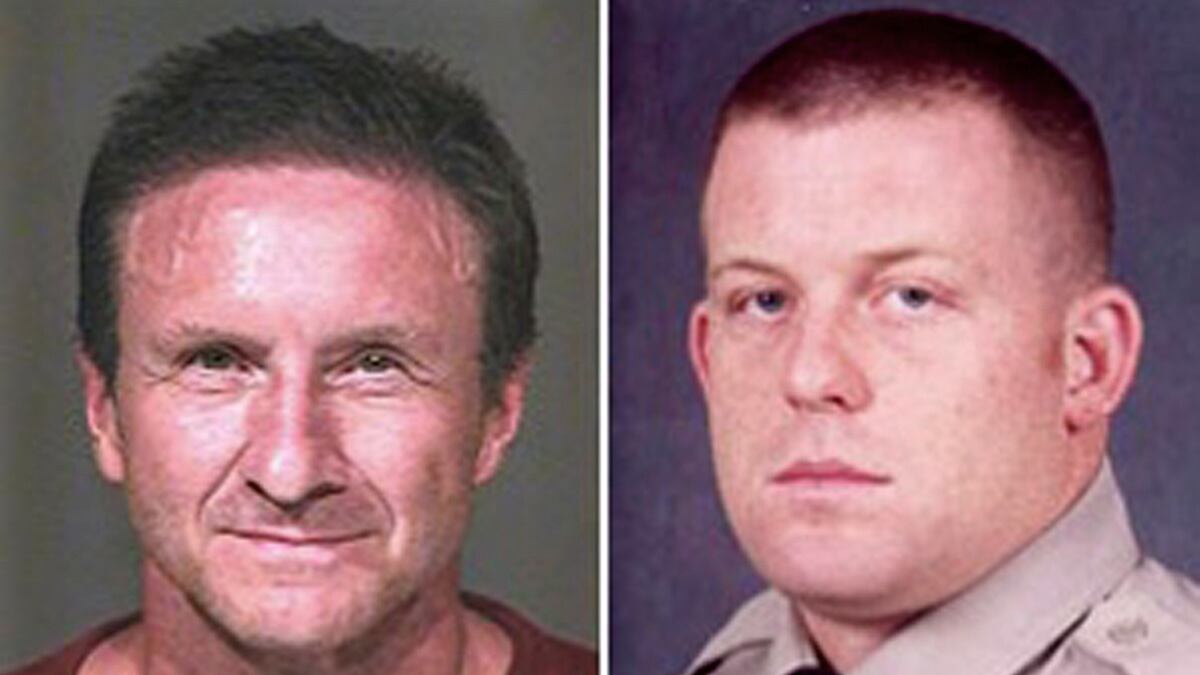On Valentine’s Day this year, an Arizona cop aimed his rifle at an unarmed man holding a baby. The officer, James Peters, pulled the trigger. The infant thudded to the ground, unharmed, but his grandfather, a troubled guy named John Loxas, died instantly.
It was a white-on-white shooting of the sort that often goes unpublicized in a state riven by racial tensions. What’s more, Arizona loves its guns, and aficionados were not dissuaded by the shooting of Rep. Gabrielle Giffords at a Safeway last year. But even in Arizona, Loxas’s death stood out. It marked the end of 10 years of “justifiable homicides” involving Officer Peters, who, in isolated incidents while on duty, killed or helped kill six people.
The shootings were deemed “within policy” by the police. They were, in other words, justifiable homicide.
ADVERTISEMENT
On Monday, in Phoenix District Court, the Loxas shooting was at the center of a new American Civil Liberties Union of Arizona lawsuit against the City of Scottsdale, its police chief, and Peters. The ACLU alleges in the suit that Scottsdale police “fatally shoot citizens in a manner similar to the shooting at issue here on a frequent basis,” largely because the killings are found to be “within policy” by Scottsdale police chief Alan Rodbell.
The number of shootings by Peters is “completely atypical,” says James Alan Fox, a criminologist and expert on serial killers who is a professor at Northeastern University in Boston. And they are emblematic of a disturbing national trend: police-instigated “justifiable homicides” have increased by about one third since 2000, from 300 to 400 annually, even as crime rates have declined, Fox recently reported.
An upscale Phoenix suburb, Scottsdale is known for its multimillion-dollar mansions, skilled plastic surgeons, golf resorts, elegant retail shopping, and creative fusion cuisine. The city of 220,462 has one of the lowest crime rates in the Phoenix metro area, according to the FBI, with just four murders in 2011. (The FBI doesn’t count killings by police, unless they are judged to be a crime, and in Scottsdale at least, most aren’t.)

“No one would confuse Scottsdale, Ariz., with Mayberry R.F.D., but by the same token, we are also not talking about South Central L.A. or Detroit,” says Dr. Steven Pitt, a Scottsdale forensic psychiatrist who consults with law-enforcement agencies.
And yet Peters killed or helped kill six men, including one who’d stolen a Krispy Kreme truck in West Phoenix and was chased by police to Scottsdale. When his tires were shot out, he ran into a neighborhood Safeway and held a deli worker hostage at gunpoint.
That’s when Peters killed him.
Peters got a Medal of Valor from the Scottsdale Police Department for that shooting, back in 2006.
Loxas seemed to be as mentally disturbed as the Krispy Kreme guy. When Peters was called to Loxas’s house on Valentine’s Day, neighbors said Loxas had threatened them with his gun after kicking over a garbage can. On his Facebook page, Loxas announced his run for president of the United States in 2012. Scottsdale police later reported he had guns in his house, although they acknowledged he was unarmed when Peters killed him.
A sturdy man with small, widely spaced eyes and red hair, Peters became a Scottsdale cop in 1999, after graduating from college. In his personnel files (PDF), posted by ABC News' Phoenix affiliate, Channel 15, he wrote that he’d been a “swift water rescue technision” [sic] and that his life “has always involved customer service, dealing with problem’s [sic] and finding a solution, protection and physical activities.” He had worked as a construction manager, bus driver, river guide, ski-lift supervisor, and grocery-store clerk.
A star baseball player in college, he also volunteered as a Little League coach.
Throughout his career, he was commended for going the extra mile to arrest prison escapees, fraudsters, and bank robbers. He was praised for being physically fit, for assisting in training canine officers, and for helping out citizens in need. In 2009, when President Obama came to Phoenix, Peters was among those who kept the crowd of 65,000 in control.
Peters “goes above and beyond each day to WOW those he works side by side with,” a police aide wrote in a letter in Peters’s personnel records. Peters took the time, the aide wrote, to “show a young child what he is about, including allowing children to try on his uniform.”
But there were signs early on that the overachieving cop wasn’t always overachieving. In 2002, Peters and a rookie officer arrested a belligerent man, and the rookie “deliberately applied the brakes several times, causing the prisoner to strike the cage divider that separates prisoners from the front seat passengers,” according to Peters’s personnel file. Peters did not correct the rookie and later “admitted to making several antagonistic and derogatory comments to the prisoner.”
“You have been counseled several times in the past 12 months by your supervisor for using profanity or being rude to citizens,” a superior officer wrote.
Three years later, Peters pointed his service gun at his own face during a squad briefing. He said he was checking to see if the gun had any water in it, as it had rained the night before.
Paradoxically, during part of the time Peters was carrying out “justifiable homicides” while in uniform, two serial shooters were terrorizing Phoenix. One man, Dale Hausner, was sentenced to death for killing six people.
On Feb. 16, 2012, two days after Peters shot Loxas, the department issued a 73-page summary of his disciplinary records. The ACLU contends in court records that Peters had a “long history of use of force against civilians, including dozens of incidents involving the use of Tasers, other projectiles and other firearms-related incidents.”
Shortly after the Loxas shooting, Peters retired from the police force, according to the ACLU. Asked for comment, David Pubins, a public-information officer for the Scottsdale Police Department, said in an email that Peters’s case is still under review. “We urge the community to allow this very complex process to take place. When the entire process is complete, the results will be made public,” Pubins said.
Few police officers even shoot their guns in the course of their careers, says Roger Clark, a former Los Angeles County sheriff’s deputy. It would be hard to “imagine a set of facts” that would lead a cop to be involved in the deaths of six people, he said.
But former Phoenix police sergeant Andy Hill, who retired and is now a crisis-management consultant, warns that Peters should not be judged too hastily. His job assignments may have placed him in more dangerous, life-threatening situations than those of other officers, Hill says.
That message came too late for Loxas’s daughter, Alexandria, a petite brunette. “We as a community put our trust in the Scottsdale Police Department to serve and protect us … I do not feel protected,” she wrote in a statement she read Monday to reporters. “Not only is our trust betrayed, but my father is gone.”






